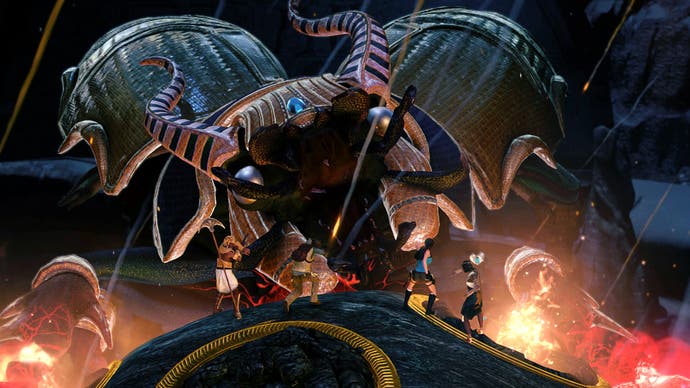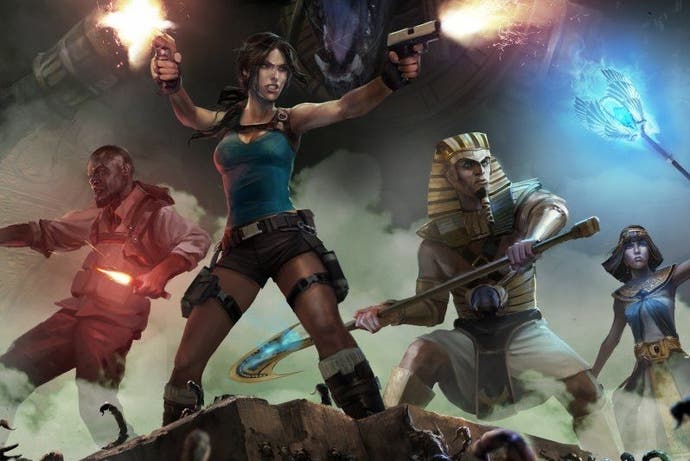Lara Croft and the Temple of Osiris is the best of classic Tomb Raider
The best by a country Nile.
Last year's Tomb Raider reboot understandably earned itself plenty of fans. It was a smart, modern revamp for the slightly dated franchise from a developer keen to cast off a decade of baggage. But not everyone preferred the game's pared back approach.
The reboot did a decent job of placing you in the shoes of its rookie heroine, of guiding her through the brutal island of Yamatai and proving herself a capable survivor. But I missed something of the older, more confident Lara - the one who had brushed off twice the crap Indiana Jones had faced, at half the age, while still maintaining a fearsomely British accent. That version of Lara Croft was a dinosaur battler, an explorer of Atlantis, a wielder of Thor's hammer. I also despaired at the game's brief, "optional" tombs.
So, credit to developer Crystal Dynamics, you are now able to choose which Lara you prefer. Rise of the Tomb Raider, a sequel to the reboot, is due next year. But in the meantime, and for those wanting a more classic-feeling Tomb Raider title, there's Lara Croft and the Temple of Osiris, a sequel to 2010's successful platformer Guardian of Light.
Not only does Temple of Osiris mirror much from that title - its twin-stick controls for moving and shooting plus an isometric camera - it is also a nostalgic return to the series' origins in general. Think health packs rather than health regeneration, lunatic Egyptian gods rather than salty human islanders, plus the unmistakable tones of Keeley Hawes, who returns to the franchise to voice Osiris' classic Croft.

The story is your usual Tomb Raider fare - an argument among ancient gods 2000 years ago has somehow trapped Lara and fellow explorer Carter Bell inside the tomb of Osiris, whose remains have been scattered and somehow need to be found. Joining you in this quest are, naturally, Osiris' wife Isis (also his sister - those naughty Egyptians!) and their son Horus (yep...).
It means that up to four players can now team-up and play cooperatively, and the game has a neat way of rejigging itself to fit the number of players along for the ride. On her own, Lara is armed with a torch, grapple hook, bombs and dual pistols. She's your default character if you want to play through the game by yourself.
Add a second person and they'll control Isis, who can use her handy Egyptian magic to operate platforms and create a block of energy that other players can stand upon. She does all this using her beam staff, which is instead awarded to Lara while playing by yourself. Third and fourth players, as Carter and Horus, get other weaponry to choose from.
But it's not just your load-outs that will change. Entire rooms will alter to become puzzles requiring multiple characters to solve, if said characters are there. We ran through a room a couple of times with different numbers of characters. On our own we could clamber around as Lara and activate switches ourselves with the staff. When playing as a pair, previous grapple points had moved and we needed to rely on Isis' block power to reach areas that had been raised, then use our grapple hook to pull up the other player in return.
Just like in Guardian of Light there's a good balance of being both a co-operative experience and a competitive one. Both players need to make it through rooms to progress, but there's nothing to stop you griefing your fellow players along the way. You can choose to let your friends fall down pits of spikes, you can collect all the stat-buffing rings and snatch up all of the score-boosting gems. Or you can work through the dungeon as team. It's up to you.

The early stages we played were fairly straightforward, and I get the sense that Crystal Dynamics doesn't want to leave you hanging around too long scratching your head. Simple 'roll the ball into that conveniently sized hole' puzzles won't delay you and your friends' rampage through levels, and neither will the game's floods of scarabs and skeletons.
It remains to be seen what the remainder of Temple of Osiris' levels have to offer, but already I've spotted a couple of bosses that take a little longer to defeat. The first was a screen-filling lion, hippopotamus and crocodile hybrid who activates a fast-paced chase sequence across crumbling platforms. Next up was a mighty scarab beetle.
These moments offer a break from the game's steady dungeon crawling but also allow its upgraded engine to flex its muscles. Temple of Osiris is only being released for PC, PlayStation 4 and Xbox One, and Crystal Dynamics are keen to show off what the next version of their Guardian of Light technology can do. Characters are now better animated, the game's fixed camera angles can now break for different shots, while the huge 3D bosses are rendered in greater detail.
Lara Croft and the Temple of Osiris is a Tomb Raider game not in name but very much in spirit. With its unashamed focus on the franchise's classic themes and no attempt to hide the series' slightly kooky mystical origins, it is a back to basics approach of a very different kind to the Tomb Raider reboot last year. It's a very welcome one, too, and a fine chance to reminisce and relive some of the best of the series' past.




